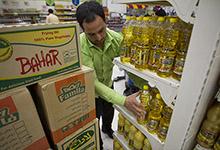
Typical street scene in Santa Ana, El Salvador. (Photo: iStock)
IMF Survey : Iran Presses Ahead with Economic Reforms
April 4, 2014
- Iran has taken important steps to lower inflation
- Near-term outlook remains uncertain
- Structural reforms to support non-oil growth are needed to sustain long-term economic recovery
The Islamic Republic of Iran has made progress toward stabilizing its economy in recent months, but the country needs to advance comprehensive reforms to lay the basis for a return to growth and create needed jobs, the IMF says.

Store in Tehran: Iran’s inflation rate has gone down in recent months, thanks in part to central bank actions (photo: Morteza Nikoubazl/Polaris)
ECONOMIC HEALTH CHECK
In their annual health check of the economy, the first in 2½ years, IMF economists say that Iran’s near-term economic outlook remains uncertain. Facing continued constrained prospects for oil revenues and international transactions, Iran is expected to see its real GDP growth begin to stabilize in the current fiscal year after two consecutive years of sharp contraction. The still-weak recovery is expected to benefit from potential improvements in the external environment and some early signs of modest revival in growth in domestic demand.
The new Iranian administration that took office in August 2013 has made some headway in improving the external environment and confidence in the outlook, the report notes. The authorities have reached an interim agreement with the P5+1 group of countries (the five permanent members of the United Nations Security Council plus Germany). This agreement (which took effect in January 2014 and provides for a limited, temporary easing of sanctions) allows Iran to stabilize oil exports, grants some access to Iran’s funds held abroad, and temporarily waives sanctions on petrochemical exports and the automobile industry.
Iran now needs to focus on the domestic reform agenda to fully benefit from the country’s economic potential. “This window of opportunity to advance comprehensive reforms should not be missed,” said Martin Cerisola, Assistant Director of the IMF’s Middle East and Central Asia Department.
Addressing weaknesses
Large shocks and weak macroeconomic management have had a significant impact on economic stability and growth in the past several years, despite Iran’s considerable progress in raising per capita income and living standards in the preceding decades. A combination of shocks—associated with the implementation of the first phase of energy subsidy reform, ambitious and inadequately funded social programs, and a marked deterioration in the external environment stemming from the intensification of trade and financial sanctions—have weakened the economy in the past several years.
The authorities now need to focus on how to address some of the longstanding challenges in the structure of the economy to achieve growth, the IMF report says, noting that the government has begun taking important steps in this direction.
To reduce and stabilize inflation, the central bank has kept tighter control over base money in the past seven months. This effort has been supported by the agreement to remove the financing of the Mehr Housing Project—an ambitious affordable housing project launched in 2007—from the central bank’s balance sheet. These measures to control inflation, along with favorable global food prices and the appreciation of the currency, have allowed the country to lower the 12-month inflation rate to about 23 percent in early 2014, sharply down from 45 percent last June.
Getting back on track
However, more reforms are needed to get Iran’s economy back on a sustainable growth track. The authorities should avoid postponing reforms and “muddling through” in the hope of an improved external environment, the IMF report stresses. A three-pronged strategy to fight the country’s twin problems of low growth and high inflation should be centered on tightening monetary policy, balanced fiscal consolidation, and structural reforms.
The 2014 budget bodes well for this strategy by providing a good balance between disinflation and supporting the economy. Measures to begin broadening the revenue base away from oil—such as the authorities’ decision to bring forward and increase the scheduled value-added tax (VAT) rate, as well as reforms to strengthen tax administration and reduce exemptions—will help lay the ground for a sustainable fiscal policy. The IMF report also observes that reforms to the fiscal policy framework should strengthen its countercyclical role, limit fiscal risks, and enhance macroeconomic coordination.
Reforms to the monetary policy framework are also essential to fully establish economic stability, as is the intended move to unify the foreign exchange market by mid-2015. Progress in simplifying and refocusing the central bank’s mandate toward price stability and steps to restructure institutional decision making will be key in the success of these reforms.
At the same time, reforms to boost productivity are needed to unleash Iran’s entrepreneurial and human capital potential to create much-needed new jobs. High unemployment of about 24 percent among youth requires reforms to the labor market. There is large scope to improve the business environment, the report notes, and this can provide a significant boost to productivity and growth in the years ahead.
The implementation of Iran’s subsidy reforms remains a priority, the IMF report notes. The design of the reforms—replacing price subsidies with universal cash transfers to households—has been exemplary, even though the first phase has faced significant difficulties. It will be key to ensure that the second phase of the reform proceeds with the right supporting framework and macroeconomic policies.
The report discusses two illustrative medium-term scenarios for the Iranian economy. These scenarios show that in the absence of a sharp increase in oil prices or production and without solid progress on structural reforms, Iran will continue to face significant constraints in achieving sustainable growth and lower inflation.


